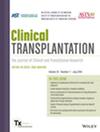Dual-Energy X-Ray Absorptiometry-Derived Advanced Hip Analysis and the Trabecular Bone Score Are Associated With the Diagnosis of Fracture Following Kidney and Simultaneous Pancreas-Kidney Transplantation
Abstract
Background
Patients with kidney failure have elevated fracture risk that remains high following kidney transplantation. This study aimed to assess whether dual-energy x-ray absorptiometry-derived advanced hip analysis (AHA) and the trabecular bone score (TBS) improve bone mineral density (BMD)-based post-transplant fracture prediction.
Methods
Patients receiving kidney-only or simultaneous pancreas-kidney (SPK) transplants underwent immediate post-transplant dual-energy x-ray absorptiometry to provide BMD, the TBS, and AHA parameters; femoral neck, calcar, and shaft cortical thickness (CTh), and femoral neck buckling ratio (BR), an index of structural instability. Patients received treatment to reduce post-transplant BMD loss, using an established risk algorithm. Hazard ratios were determined using Kaplan–Meier and Cox proportional hazard models.
Results
Of 357 transplant recipients, 289 (83%) received a kidney-only transplant. There were 83 incident fractures over a median of 4.4 years (IQR: 2.5–5.5). Fracture was associated with type 1 diabetes mellitus (p < 0.001), former smoking (p = 0.006), lower 25-hydroxyvitamin D (p = 0.003), BMD at total proximal femur and neck of femur (p < 0.001) and spine (p = 0.008), lower CTh at the calcar (p = 0.005) and shaft (p = 0.023), higher BR (p = 0.016) and lower TBS (p = 0.047). Following multivariable adjustment, type 1 diabetes mellitus, 25-hydroxyvitamin D, smoking, and femoral neck BMD remained significant. Using the BMD-based risk algorithm, inclusion of the BR improved the model fit.
Conclusion
BMD, the TBS, and AHA parameters are associated with incident fracture in kidney-only and SPK transplant recipients. Pre-transplant smoking, lower 25-hydroxyvitamin D and BMD are potentially modifiable factors that could reduce post-transplant fracture risk.


 求助内容:
求助内容: 应助结果提醒方式:
应助结果提醒方式:


